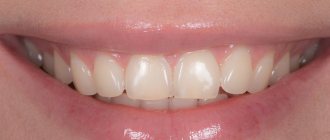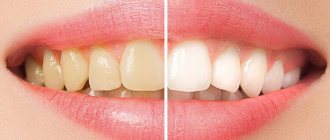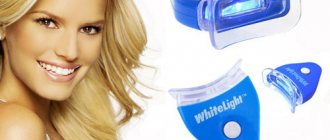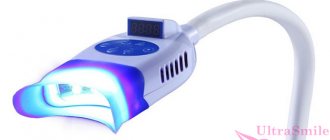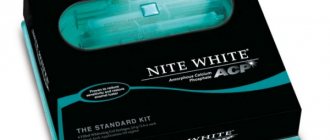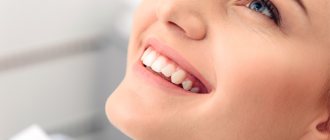12.06.2018
Dentists recommend choosing the Zoom whitening system - this is the safest and non-traumatic option. To ensure that the procedure does not cause harm, it is worth undergoing an examination at a clinic, where the doctor will make sure that there are no contraindications.
Every third patient has contraindications to this procedure. Therefore, before asking the question whether teeth whitening is harmful, you should consult a dentist. And you definitely shouldn’t buy lightening products on the Internet or in a store and test them on yourself.
Types of professional teeth whitening
Reviews about types of teeth whitening on the Internet make many patients believe in the myth about the effectiveness of hydrogen peroxide purchased at the pharmacy, soda, activated carbon and other simple methods. Following such dubious advice is not only pointless, but also fraught with dangerous consequences - burns of the oral cavity, damage to the enamel and increased sensitivity of the teeth. In fact, there are only two types of professional whitening – in-office and at-home.
Contraindications
Office, home or self-lighting is strictly prohibited in the following cases:
● the patient has deep caries - in this case, the active substance quickly penetrates into the dentin, which causes burns;
● increased sensitivity – the procedure will aggravate the problem;
● dental plaque, tartar - in this case, you will first need to do hygienic cleaning to remove soft plaque, otherwise the effect will not be noticeable;
● taking medications that affect sensitivity to ultraviolet light - for example, ibuprofen;
● patient's age is less than 18 years;
● pregnancy or breastfeeding.
Main contraindications
In-office bleaching
This term in dentistry means teeth whitening under the supervision of a doctor using gels based on hydrogen peroxide or urea, as well as catalysts in the form of ultraviolet light or a laser beam. The chemical composition affects only 20% of the organic substances contained in hard dental tissue (dentine) and does not cause any harm to the teeth. The final result of the procedure depends on the initial shade of the teeth, determined according to the VITA scale. In most cases, it is possible to achieve a lightening of 5 to 10 tones. Let's look at the features of each type of teeth whitening in the clinic.
Photobleaching
During photo-whitening, the whitening gel is applied to the tooth surface from the front. The action of the product is accelerated by a lamp with ultraviolet radiation. One session lasts 15 – 30 minutes. The maximum change in tooth shade is possible by 8 – 10 tones. The cost of the service is about 10,000 rubles.
Laser whitening
The reagent on the teeth is catalyzed by a laser beam rather than an ultraviolet lamp. Each tooth is processed separately. In one laser whitening procedure, you can improve your color by 12 shades. The price of an effective technique is proportionally high - from 20,000 rubles per session.
Chemical bleaching
In chemical whitening, a whitening gel is applied to the surface of the teeth, and no ultraviolet light or laser is used. The method is gentle, so teeth become whiter by only 5 to 7 tones. The cost of the procedure is about 12,000 rubles.
In-canal whitening
It is used when the tooth has darkened due to filling the canals with coloring materials. The dentist drills a hole in the tooth cavity, applies a brightening agent and places a temporary filling. After achieving the desired result, the final restoration of the tooth is carried out. Endo-whitening costs approximately 1,000 rubles per tooth.
Contrary to what many patients believe, the popular Air Flow procedure involves mechanical cleaning and not teeth whitening. A powerful stream of air, water, soda and other components removes bacterial and hard plaque, polishing and leveling the tooth surface. After the session, the teeth visually become whiter because they have been cleaned of impurities and returned to their natural color. The same can be said about ultrasonic whitening.
How does the procedure work?
The main preparation before the whitening procedure, which guarantees uniform lightening of the enamel, is teeth cleaning (“Air Flow” and ultrasound). Professional whitening is carried out in a regular dental chair. Initially, it is necessary to isolate the mucous membrane so that the bleaching agent does not come into contact with it. Next, the doctor applies it to the teeth (for about 20 minutes) and uses a special lamp. This procedure is repeated several times, completely washing off the composition. The average duration of the entire procedure is 1.5 hours. It does not cause any painful sensations. Some patients feel a slight tingling sensation - this is a normal reaction.
The procedure has a cumulative effect - oxygen continues to work on the teeth behind the doors of the dental office. The final result can be assessed after 1-2 weeks. It is important to adhere to a “white” diet for the first 2-3 days after the procedure: give up coffee, black tea, red wine and any coloring products. The resulting effect will last about 2-3 years (if you regularly sign up for professional hygiene every six months).
Home whitening
The method is suitable for those who want to whiten their teeth without risk to health and save a lot of money. However, before using whitening at home, it is recommended to consult a dentist to avoid mistakes when choosing the appropriate product and in the process of using it.
Home whitening systems with trays
Gel with individual trays for home whitening is issued in dentists after consultation with a doctor. Simpler sets with standard mouth guards can be purchased at the pharmacy. Due to the low concentration of hydrogen peroxide or urea in the gel, teeth are lightened by 5 to 8 tones. The price of the set varies from 2,000 to 7,000 rubles. The cost of making an individual mouthguard will be about 6,000 rubles.
Stripes
The devices contain a gel with a small content of hydrogen peroxide. The strips are applied to the teeth for about 30 minutes for a month. The effect is lightening by 3 – 5 tones. The cost of the kit is from 1,000 to 4,000 rubles. Perhaps the most effective means of this type will be Crest strips.
Gels and varnishes
The teeth are coated with a whitening agent with remineralizing components using a brush or brush. As a rule, the solution does not require rinsing and is used regularly for two weeks. Teeth become 1–2 shades whiter. Purchase costs will range from 300 to 1,000 rubles. One example of such products is the Blanx whitening pencil.
Whitening pastes
Toothpastes, rinses, brushes and flosses with a whitening effect in rare cases “increase” whiteness by a maximum of 1 tone. Experts recommend using such products to maintain the results of professional whitening. The simplest whitening paste can be bought at an affordable price - from 150 rubles. Low-abrasion toothpaste with a brightening effect, Extreme Whitening Swissdent, will cost more.
How to remove stubborn plaque?
Abrasives
You can lighten your teeth using highly abrasive pastes. From 10% to 50% of the volume of such pastes is occupied by abrasives - hard polishing particles, with the help of which plaque and food debris are removed.
The cleaning and polishing properties of toothpaste depend on the concentration of abrasive particles, their size, shape and hardness. Silicon dioxide, calcium carbonate (chalk), sodium metaphosphate and even diamond dust are used as abrasives in pastes.
In dentistry, a single standard has been adopted for assessing the abrasiveness of hygiene products and their impact on enamel - the RDA (Relative Dentin Abrasivity) abrasivity index, where:
- 0–30 – low abrasiveness;
- 30–80 – moderate abrasiveness;
- 80–150 – high abrasiveness;
- >150 - polishing pastes for use no more than 1-2 times a week.
Pastes with high abrasiveness clean more intensively and are suitable for smokers and coffee lovers.
It is better to use such pastes in cycles or alternate with strengthening ones, otherwise you can injure the enamel. If you have sensitive teeth, chips and cracks in the enamel, highly abrasive toothpastes will not be suitable. Pastes with low and medium abrasiveness can be used every day. They often add additional bleaching agents - enzymes or peroxides.
Marvis Whitening Mint Toothpaste Whitening 85 ml
Toothpaste Apagard Smokin 100 ml
ApaCare Polish Polishing Toothpaste
ISME RasYan Herbal Clove Polishing Toothpaste
Enzymes
You can carefully and safely lighten enamel with pastes containing plant components - enzymes and extracts. They break down and loosen plaque, making it easier to remove. Such pastes have a low level of abrasiveness, which means they are safer for enamel. Enzymes are obtained from fruits: bromelain - from pineapple, papain - from papaya. You can brush your teeth with such pastes every day, even with sensitive enamel.
Yotuel Whitening Pharma toothpaste
Tooth cream SWISSDENT CRYSTAL (50 ml)
Toothpaste ROCS (ROCS) PRO Delicate whitening Sweet mint
Blanx Pro Pure White Toothpaste Pure white
Light
Lightening due to blue particles and pigments. Tooth enamel is able to absorb, reflect and scatter light, which affects its visible shade. Pastes containing blue particles, or pigments, create the optical illusion of whiteness. The blue undertone visually removes yellowness - this effect is used in detergents for white laundry. Such pastes give a short-term effect, because the pigments work only on the surface.
As a rule, pastes with pigments have a low or medium level of abrasiveness, since the emphasis is on the coloring effect. There are no contraindications for such pastes.
Blanx Pro Pure White Toothpaste Pure white
Blanx White Shock toothpaste 50 ml with activator lamp
Pros and cons of types of teeth whitening
Photobleaching
- Instant results.
- Uniform impact.
- The duration of the session is no more than an hour.
- Whitening by 8 – 10 tones.
- The occurrence of tooth sensitivity during and after the procedure.
Laser whitening
- Instant results.
- No discomfort during the procedure.
- Maintaining the acid balance of the oral cavity.
- Strengthening enamel.
- Whitening by 12 tones.
- The duration of the session is more than an hour.
- Uneven teeth whitening.
- High price.
Chemical bleaching
- Instant results.
- Uniform impact.
- Acceptable price.
- Simplicity of the procedure.
- Whitening by 5 – 7 tones.
- The occurrence of tooth sensitivity during and after the procedure.
- The need for several sessions.
In-canal whitening
- Local effect on tissue.
- Painless.
- Whitening by 5 – 7 tones.
- Weakening of dental tissues.
- Prohibition on repeating the procedure.
Whitening on trays
- Affordable price.
- Possibility to use the mouth guard at any time.
- Whitening by 5 – 8 tones.
- The duration of the course is 1 month.
Lightening strips
- Visible effect after the third application.
- Affordable price.
- Whitening by 3 – 5 tones.
- Inconvenient to use.
- The duration of the course is 1 month.
Varnish or pencil
- Ease of use.
- Minimum costs.
- Lightening by 1 - 2 tones.
- Poor efficiency.
Contacting the Doctor Martin Clinic
In Moscow, teeth whitening is offered by the reliable dentistry “Doctor Martin”. Experienced specialists perform procedures efficiently and safely. At the initial appointment, the doctor will examine the teeth, agree with the patient on the desired enamel color and perform whitening. Each patient will leave the clinic completely satisfied with the results obtained. The pricing policy of Doctor Martin dentistry is loyal, the cost of the service is lower than in other private clinics in the city (you can find out more about the price list on the website). To sign up for the procedure, just call the phone number provided or fill out a standard form online.
Whitening dental strips
Whitening strips are one of the most affordable products that can be purchased at any pharmacy. At their core, these are narrow strips of polyethylene, with a layer of brightening composition applied to the inside, in which the main active component will be hydrogen peroxide with a content of up to 10%. The strips are sold in sets, which contain separate stickers for the upper and lower dentition.
There is nothing complicated in using the product: just attach the strips to the outside of the teeth and leave for half an hour. During this time, the brightening substance will begin to act, triggering chemical reactions in the enamel coating that will gradually destroy the colored pigments. Strips are used for teeth whitening in a course, the average duration of which can be up to 14 days. It is advisable to use the stickers twice a day - in the morning and in the evening, so the positive effect will come much faster.
If you believe the reviews of the strips from people who have tried them from personal experience, then there is no particularly pronounced whitening effect from their use, but there is a high probability of encountering negative side effects, among which buyers of the product mention burns and inflammation of the gums, increased sensitivity of teeth to to various external stimuli.
